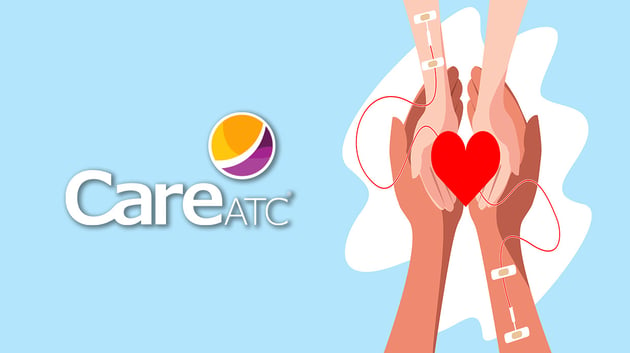 National blood donation awareness month is coming!
National blood donation awareness month is coming!
Since 1970, January has been recognized as National Blood Donation Awareness Month. The combination of recovering from the holiday rush, unpleasant weather, and seasonal illnesses has a strong negative impact on donations and blood drives. In this article, you will learn why blood donation is necessary, how to donate, and how to maintain adequate iron stores when donating.
During this season of giving, consider these two gifts:
- Give yourself the gift of good health! Schedule an appointment at a CareATC Health Center today for an annual physical to ensure you are in tip-top shape.
- Give someone else the gift of life by donating blood. Read more about blood donation and how to prepare your body to give this generous gift.
Why Donate Blood?
Each time you donate blood, you can save up to three lives with only an hour of your time. Plus, you get some snacks and friendly company! Since there is no substitute for human blood, healthcare professionals and their patients rely on donors for lifesaving treatments. Blood is especially needed during times of crisis like natural disasters, other extreme weather, disease outbreaks, or any event resulting in increased hospitalizations. However, this does not mean you should wait for a local or emergency to donate – blood typically takes two days for processing before it is available for use, so a stable supply is essential for proper emergency response. (1)
How to Donate Blood
The following are the Red Cross guidelines for donation requirements. To donate, you should: (2)
- Be in good health and be feeling well
- Be at least 17 years old in most states (16 years old with parental consent in some states)
- Weigh at least 110 pounds. Additional weight requirements apply for donors 18 years old and younger and all high school donors
- Not have donated blood in the last 56 days
If you decided to donate, here are some tips to help you prepare:
- Drink lots of water! Add an extra 16oz leading up to your donation
- Rest up. Get a good night’s rest
- Eat well. Fuel up on healthy, iron-rich foods (keep reading to learn about iron!)
- Make sure to bring your ID
After you have donated, here are some tips for healthy recovery:
- Have a snack and rest for a few minutes
- If you feel faint, sit or lie down and avoid sudden movements. A snack or beverage containing sugar may help
- If you have a history of feeling faint after blood donation, ask for a little extra time before leaving your donation area, and get up slowly
- Drink extra water, avoid alcohol, and avoid strenuous activity or heavy lifting in the following 24 hours
- Continue to focus on iron-rich foods over the next few days
What You Need to Know About Iron
Donors must meet certain hemoglobin requirements in order to donate. Hemoglobin is an easily accessible measurement of sufficient iron stores. Minimum hemoglobin levels required for donation are 13 g/dL for men and 12.5 g/dL for women (for reference, normal levels are 13.5-17.5 g/dL for men and 12.0-15.5 g/dL for women). Your hemoglobin will be checked before donating. (3)
Iron-rich foods are always good to include in your diet but should be of an extra focus if you plan on donating blood. Include more iron-rich foods in the weeks before and after donation, especially if you have had low iron in the past. Heme iron from meat sources is better absorbed than non-heme iron from plant sources but eating non-heme foods with Vitamin C or a small amount of meat will help your body absorb the iron. However, brown teas, coffee, and milk may hinder absorption. Some high-iron foods include red meat and poultry, eggs, tuna, iron-fortified breads and cereals, dried fruits (raisins), leafy greens, beans and lentils, peas, pumpkin seeds. Try these tasty combinations of iron + Vitamin C foods to get the most iron out of your meals!
- Lentil soup with spinach, bell peppers, tomatoes
- Iron fortified cereal with fresh strawberries
- Toast with orange juice or fresh oranges
- Stir fry that includes kale, peas, and broccoli
If you discover that your hemoglobin levels are low, be sure to follow up with your doctor. Low hemoglobin may be related to iron deficiency, but it could also be related to another vitamin deficiency, such as folate or Vitamin B12. Your provider can review your labs and order additional tests if needed to better understand the cause.
Many people wonder if various medications or lifestyle factors limit their eligibility for donating blood. This webpage covers frequently asked questions about eligibility: https://www.redcrossblood.org/faq.html#eligibility. If you have received the Pfizer or Moderna COVID-19 vaccine, you are still eligible to donate. (1)
Go to https://www.redcross.org/give-blood.html to find a Red Cross donation site near you. Your state may have a blood collection agency as well to help your local community.
|
Give yourself the gift of good health.
|
References

 Posted by
Posted by


